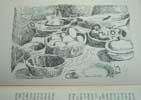Summer Cooking
SUMMER COOKING by ELIZABETH DAVID. LONDON MUSEUM PRESS. (With a 1" vignette of carafe and glass of wine.)
FIRST EDITION. 1955. 1fep. Half-title. [1] Title page. [1] 1pp Contents. [1] 7-10 Introduction and Acknowledgments. 11-244. 245-256 Index. 1fep. Light green cloth binding with gilt lines and lettering on spine. Internally as new. With Adrian Daintrey illustrations through out. A touch faded at the spine ends. With the rare original Adrian Daintrey d/j with slight chipping at spine ends and cover folds with little loss. Protected by a plastic cover. Also enclosed is a letter addressed to Richard C. Laade from E.D. postmarked 2.11.88. Inside the letter is a small square of paper stating 'You Must have quite a collection E.D.', also dated 2.11.88. (A little research on the web revealed that Richard Laade is/was an inveterate collector of signatures. This helps to explain the rather cryptic message and size of the letter). Also rather interestingly and unusually, Elizabeth has signed her name in very small writing on the inside of the letter as well. A very nice scarce copy that gets elevated to rare with the original d/j and the signed letter.
- Born Elizabeth Gwynne, she was of mixed English and Irish ancestry, and came from a rather grand background, growing up with three sisters in the 17th century Sussex manor house, Wootton Manor. Her parents were Rupert Gwynne, Conservative MP for Eastbourne, and the Hon. Stella Ridley who came from a distinguished Northumberland family. Her uncle, Roland Gwynne, later became Mayor of Eastbourne and may have been a lover of suspected serial killer John Bodkin Adams. She studied at the Sorbonne, living with a French family for two years, which led to a love of France and of food. At the age of 19, she was given her first cookery book, The Gentle Art of Cookery by Hilda Leyel, who wrote of her love with the food of the East. "If I had been given a standard Mrs Beeton instead of Mrs Leyel's wonderful recipes," she said, "I would probably never have learned to cook." Gwynne had an adventurous early life, leaving home to become an actress. She left England in 1939, when she was twenty-five, and bought a boat with her married lover Charles Gibson-Cowan intending to travel around the Mediterranean. The onset of World War II interrupted this plan, and they had to flee the German occupation of France. They left Antibes for Corsica and then on to Italy where the boat was impounded, having arrived on the day Italy declared war on Britain. They were eventually deported to Greece, then made their way to the Greek island of Syros living there for a period, where she learnt about Greek food and spent time with famous bohemians such as Lawrence Durrell. When the Germans invaded Greece they managed to flee to Crete where they were rescued by the British and evacuated to Egypt, where she lived firstly in Alexandria and eventually in Cairo. There Gwynne started work for the Ministry of Information, split from Gibson-Cowan, and eventually took on a marriage of convenience to Lieutenant-Colonel Tony David; this gave her a measure of respectability but David was a man whom she did not ultimately respect, and their relationship ended soon after an eight month posting in India. She had many lovers in the ensuing years. On her return to London in 1946, David began to write cookery articles and in 1949 the publisher John Lehmann offered her a hundred-pound advance for Mediterranean Food; the start of a dazzling writing career. David spent eight months researching Italian food in Venice, Tuscany and Capri. This resulted in Italian Food in 1954, with illustrations by Renato Guttuso, which was famously described by Evelyn Waugh in the Sunday Times as one of the two books which had given him the most pleasure that year. Many of the ingredients were unknown in England when the books were first published, and David had to suggest looking for olive oil in pharmacies where it was sold for treating earache. Within a decade, ingredients such as aubergines, saffron and pasta began to appear in shops, thanks in no small part to David's books. David gained fame, respect and high status and advised many chefs and companies. In November 1965, she opened her own shop devoted to cookery in Pimlico, London. She wrote articles for Vogue magazine, one of the first in the genre of food-travel. In 1963, when she was 49, she suffered a cerebral hemorrhage, possibly related to her heavy drinking. Although she recovered, it affected her sense of taste and her libido. Her other books include: * Mediterranean Food, decorated by John Minton, published by John Lehmann (1950) * French Country Cooking, decorated by John Minton, published by John Lehmann (1951) * Italian Food (1954) * French Provincial Cooking (1960) * Spices, Salt and Aromatics in the English Kitchen (1970) * An Omelette and a Glass of Wine (1984) * English Bread and Yeast Cookery (1977) * Harvest of the Cold Months (1994) * Many various booklets for companies and her shop .





click on image to enlarge

Modern category
ref number:
11013